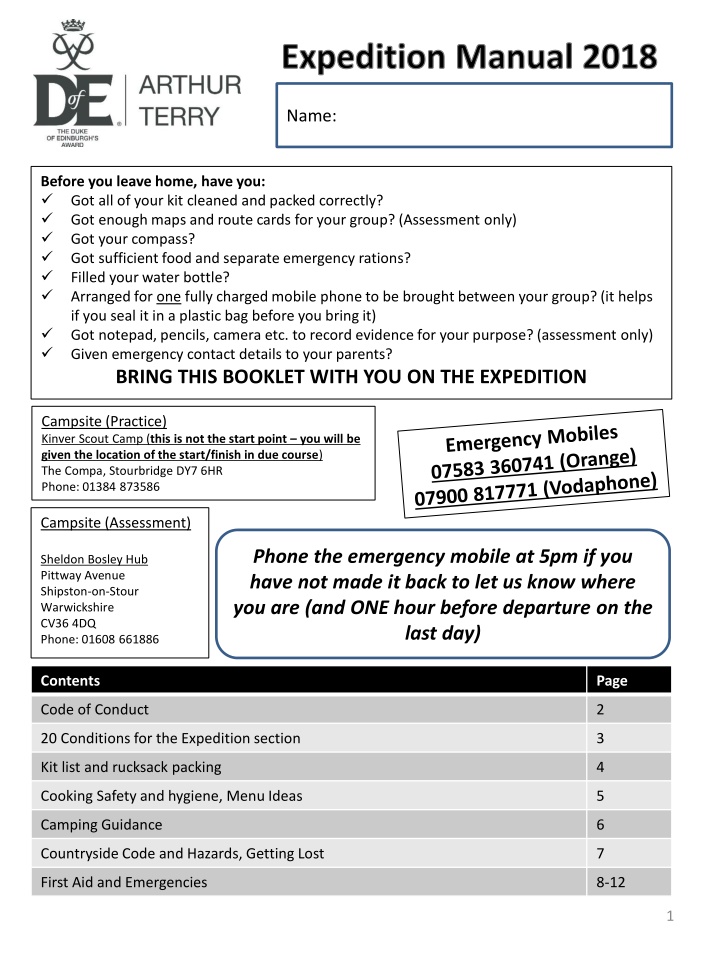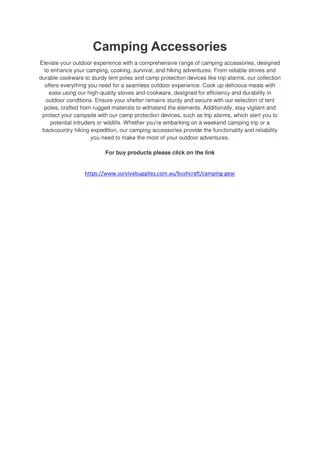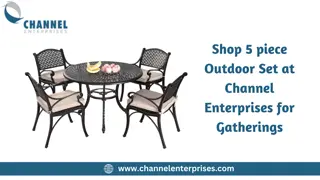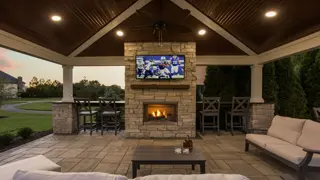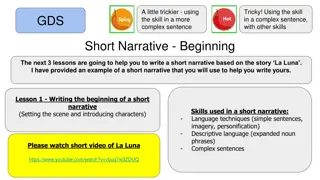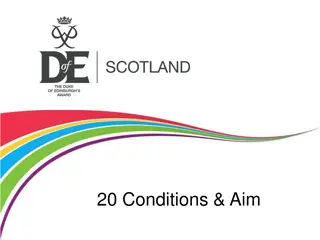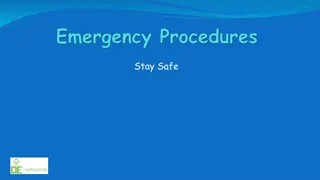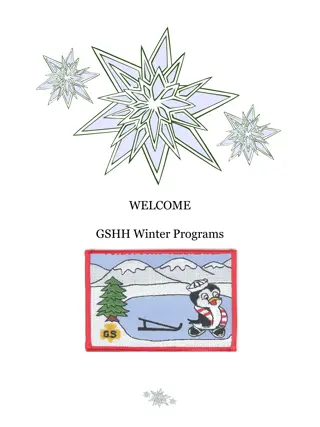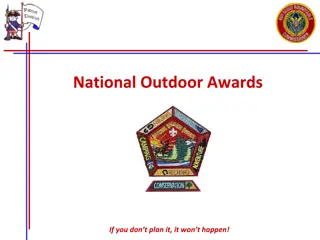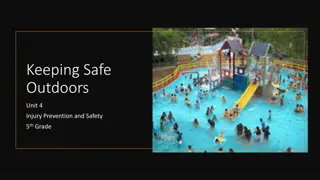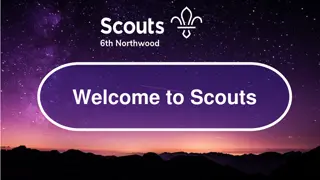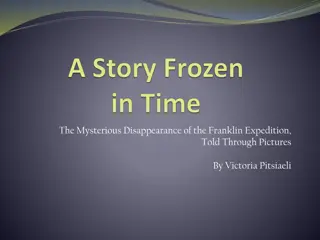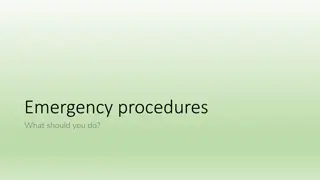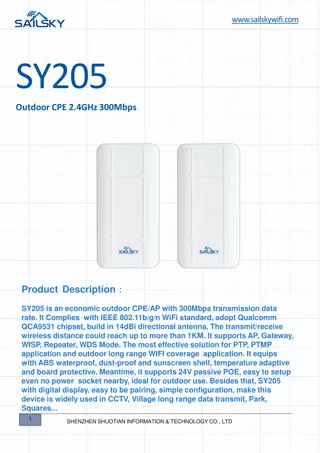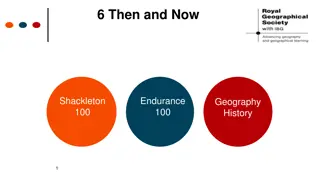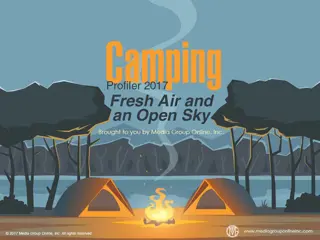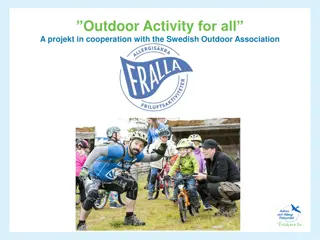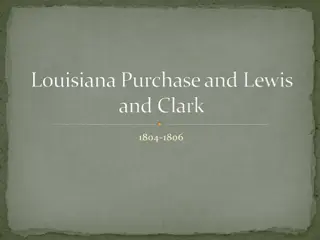Expedition Manual 2018: Preparation and Guidelines for Safe Outdoor Adventures
Expedition Manual 2018 provides essential pre-departure checklist, campsite information, code of conduct, and conditions for expeditions to ensure safety and success in outdoor activities. It covers kit preparation, emergency protocols, camping guidelines, and expectations for participants on wilderness excursions.
Download Presentation

Please find below an Image/Link to download the presentation.
The content on the website is provided AS IS for your information and personal use only. It may not be sold, licensed, or shared on other websites without obtaining consent from the author.If you encounter any issues during the download, it is possible that the publisher has removed the file from their server.
You are allowed to download the files provided on this website for personal or commercial use, subject to the condition that they are used lawfully. All files are the property of their respective owners.
The content on the website is provided AS IS for your information and personal use only. It may not be sold, licensed, or shared on other websites without obtaining consent from the author.
E N D
Presentation Transcript
Expedition Manual 2018 Name: Before you leave home, have you: Got all of your kit cleaned and packed correctly? Got enough maps and route cards for your group? (Assessment only) Got your compass? Got sufficient food and separate emergency rations? Filled your water bottle? Arranged for one fully charged mobile phone to be brought between your group? (it helps if you seal it in a plastic bag before you bring it) Got notepad, pencils, camera etc. to record evidence for your purpose? (assessment only) Given emergency contact details to your parents? BRING THIS BOOKLET WITH YOU ON THE EXPEDITION Campsite (Practice) Kinver Scout Camp (this is not the start point you will be given the location of the start/finish in due course) The Compa, Stourbridge DY7 6HR Phone: 01384 873586 Campsite (Assessment) Phone the emergency mobile at 5pm if you have not made it back to let us know where you are (and ONE hour before departure on the last day) Sheldon Bosley Hub Pittway Avenue Shipston-on-Stour Warwickshire CV36 4DQ Phone: 01608 661886 Contents Page Code of Conduct 2 20 Conditions for the Expedition section 3 Kit list and rucksack packing 4 Cooking Safety and hygiene, Menu Ideas 5 Camping Guidance 6 Countryside Code and Hazards, Getting Lost 7 First Aid and Emergencies 8-12 1
Code of Conduct All participants must: 1. Respect all requests and requirements made by members of staff supervising the expedition. 2. Behave always in a manner which will bring credit to themselves, members of staff and the school. 3. Co-operate with all members of staff, other members of their expedition group and the general public to make the expedition enjoyable, trouble-free and rewarding. 4. Be considerate to all adults and other students involved in the expedition. 5. Be punctual at all times. 6. Always carry with them the appropriate personal, camping and emergency equipment for the expedition. Staff will not provide oral painkillers to students without verbal parent consent. 7. Ensure they have sufficient nutrition for the duration of the expedition. 8. Take great care when using potentially dangerous equipment, particularly stoves and knives. 9. Never cook in or near a tent and take care with flammable materials. 10. Always stay within sight of their walking group, unless following recognised emergency procedures. 11. Abide by the Countryside Code. 12. Abide by the laws of the country and the requirements and conditions of the Duke of Edinburgh s Award. 13. Remain on designated campsites following arrival and until dismissed by staff the following day (except on Gold Expeditions). 14. Avoid making noise or carrying out other behaviours which might cause annoyance to other people (strictly silence on the campsite between 11pm and 6am). 15. Not purchase or consume alcohol or any other intoxicating substance, nor smoke for the duration of the visit. 16. Accept personal responsibility for any belongings, including the one designated mobile phone per group for use in emergencies. 17. Not bring or use music players or mobile phones throughout the duration of the expedition. 18. Not contact parents/carers without first informing a member of staff, unless in the case of extreme emergency. 19. Attend school punctually the following day in correct uniform. 20. Agree that a full report of any misconduct will be communicated to parents and will result in withdrawal from any further expeditions. 2
20 Conditions for Expeditions 1. 2. Your own physical effort, without any motorised or outside assistance. Must be unaccompanied and self-sufficient (no hitchhiking, no shop use, no phones etc). Must be supervised by an adult who is able to accept responsibility for the safety of you and your team. Must have an aim/purpose (decide based on your route) Must be properly equipped for your expedition correct kit, food etc.. Completed the required training Undertaken at least one practice expedition. You and your team must plan and organise your expedition. You must be assessed by an approved accredited Assessor 10. There must be between four and seven people in your team . 11. You must be within the qualifying age of the DofE programme level. 12. All the people in your team must be at the same level of assessment. 13. Your team must not include anyone who has completed the same or higher level DofE expedition. 14. Your overnight accommodation should be camping. 15. Your expedition must be the minimum number of days required for your DofE level. 16. Your expedition should normally take place between the end of March and the end of October. 17. Your expedition should be in the recommended environment for your DofE level. 18. You must do the minimum hours of planned daily activity for your DofE level (for Bronze it is SIX hours, not including time a the campsite). 19. You should cook and eat a substantial meal each day. ( Pot Noodle is NOT substantial!) 20. You must deliver a presentation after your expedition to complete the section. 3. 4. 5. 6. 7. 8. 9. 3
Kit Check ! Personal kit (other) Packed Personal kit (toiletries/medical) Packed Rucksack and liner (55-65 litre) Wear ! Toothbrush and toothpaste Group Kit Carried by . Packed Sleeping mat Deodorant Sleeping bag Tent inner Personal toiletries (including sanitary products) Water bottle/Platypus Tent outer Tent poles/pegs Knife, fork, spoon Small towel Mug and plate/bowl Toilet paper Stove Matches (in sealed bag) Sun cream, mosquito repellent Pots and pans Tea towel Fuel Blister plasters Emergency contact card Washing-up liquid and scourer Plasters Maps (and map case) Antiseptic wipes Compass, route cards String Paracetamol/aspirin /ibuprofen Head torch/Torch and spare batteries Personal kit (Clothing) Packed Any other personal medication (anti- histamines, inhalers, epi-pen etc.) Emergency whistle Walking boots Wear ! Alarm clock/watch Walking socks (1 per day) Notebook and pencils Water purification tablets (Gold) T-shirts/base layers (1 per day) Money Fleece top/jumper Wearing a rucksack: The hip belt should take most of the weight and should be at the top of the hip bone. Shoulder straps should be tight-ish, ensuring the rucksack is high and against your back. Be as one with your rucksack Camera Walking trousers (not jeans) Bin liners (for keeping things dry and for rubbish) Underwear Nightwear Comfy footwear(for campsite) Key Points on packing a rucksack: Shorts, Sunhat (warm weather) Put everything in waterproof bags (strong black bin liners or sandwich bags) Heavy items should be near the top of the main section and close to your back. Put water, trail food and lunch in side pockets and waterproofs, paper, pencils and camera in the top zip hood pocket for easy access. Sleeping bag and food should ideally be in the bottom compartment. Keep sharps away from the edge of compartments. Stuff clothes (in bags) around bigger items (tent, stove etc.) in the main section) Use the bathroom scales to see how heavy it is NO MORE THAN OF YOUR MASS !! Woolly hat, scarf, gloves (Cold weather) Waterproof coat/top and trousers The only kit that can be attached to the outside of your rucksack is a sleeping mat, which must be in a waterproof bag/tough bin liner 4
Menu Ideas Breakfast Lunch Dinner Trail Food Museli/porridge /weetabix with sugar, dried milk and hot water (and dried fruit/chocolate chips). Filled Baguette, crisps (day 1 only) Carton of fruit juice Flapjacks/ Cake bars Pasta and sauce with ham and squeezy cheese/cocktail sausages Fruit cocktail in plastic container Dried fruit & nuts (allergy?) Cereal bars Chocolate bars Flapjacks Pepperami Boil in bag curry, uncle bens part- cooked rice (no need to cook, just add to curry) Wayfarer Treacle Pudding Foil-packed potato, bacon and onion mix Beans & sausages in a tin Pitta bread, sandwich paste/ cheese spread, Apple Carton of Ribena All-day breakfast in a tin, pitta bread/ fried bread (needs oil) Frozen steak and sausages, dried herbs, cous cous. Instant custard Bread rolls and corned beef Sausage roll Carton of fruit smoothie Pancakes and jam/choc spread Tinned mackerel in tomato sauce, Smash/Risotto Tea/coffee/ hot chocolate sachet Coffee/tea/hot choc, sugar, dried milk Emergency Rations: Mars bars, glucose tablets, Bottle of cola, Pitta breads, chocolate spread, dried fruit, raw jelly cubes, Kendal mint cake etc. (THESE MUST BE KEPT SEPARATELY AND MAY BE CHECKED AT THE END OF YOUR EXPEDITION) HYGIENE AND COOKING SAFELY It is a good idea to try cooking one of these meals at home first. Use water from boil in the bag meals for washing up or making cup-a-soups. Use alcohol hand-gel before handling food directly and after you use the toilet. Clean mugs, cutlery and pans with washing up liquid and a scourer in hot water to kill bacteria do this as soon as you have eaten. Dirty water should be disposed of onto soft ground away from fresh water. Put all rubbish into a black bag as you go along. Meth's bottles need to remain sealed at all times and well away from stoves. Gas canisters for stoves must be re-sealable. (don t buy unless you have checked with us first) All campsites have fire extinguishers (check their location). School minibuses also have them. Stoves must be more than 1 metre away from tents (never cook in the porch or have naked flames in the tent) Check cans have a ring-pull so you don t need a tin opener. Nesting pans are best (ones that fit inside each other) Use a plastic or tin mug Taps in campsites usually contain safe drinking water. Any water from a stream must be boiled for 5 minutes (and have purification tablets added to it before drinking). 5
Considerate & Careful Camping !!! PITCHING CAMP Pitch your tent as soon as you arrive (then collapse afterwards!!). If other members of your group aren t helping with this, get them to fetch some water and start cooking or making cups of tea!! Tents must be at least 3m from any other tent. Choose a spot that is on flat ground, sheltered from the wind but NOT under a tree. Position the entrance away from the wind. Check that pegs will go into the ground easily, and insert them at a 45 angle. Peg out all of the guy ropes in line with the seams. There should never be any rubbish on the ground outside your tent use a black bag for rubbish. NO equipment or clothing should be left outside your tent. Keep everything inside or in the porch. Make your bed and get out your headtorch before it gets dark. Don t wear boots inside your tent and keep the inside clean and tidy. Don t let the inner tent touch the flysheet, otherwise it will get wet and so will you! You must be silent between 11pm and 7am. Always stay on the campsite and don t go to the toilet on your own. STRIKING CAMP Wipe the bottom of your groundsheet dry before you pack it. Tie up guy ropes and shake water off the flysheet before packing the tent away (hang up tents to dry fully as soon as you get home, otherwise they go mouldy). Make sure you check your pitch for any litter it should be spotless!! 6
1. Follow local signs, advice and access restrictions don t stray off footpaths or enter private property. Leave gates and property as you find them always close gates behind you. Litter can be dangerous to wildlife and farm animals - take all rubbish with you. Don't damage or remove rocks, plants or trees - they are homes and food for insects, birds and animals. Wild animals and farm animals can behave unpredictably, especially if they're with their young, so give them plenty of space and stay quiet. 2. 3. 4. 5. Other important points: Always walk towards oncoming traffic in single file on roads (on the right hand side of the road). Keep away from the edges of cliffs ! (obviously) Only cross rivers at fords or on stable bridges. Only cross railway lines on marked crossings. Never start a fire in the countryside. Don t contaminate fresh water. Don t make unnecessary noise that will disturb other people or animals. AVOIDING TROUBLE Hazards Stick to your route closely. Be particularly aware when near water, railways, roads, shooting ranges and quarries. Wear plenty of sunblock and a wide-brimmed hat to avoid sunburn/heatstroke. Drink lots of water (little and often) to avoid dehydration. Do not accept lifts from strangers or go into people s homes under any circumstances. The weather Check the weather forecasts before you go. Look for signs which will indicate changes in the weather eg. Put on waterproofs when clouds go black. Lightning Stay away from trees, summits and ridges, sit down on your kip mat/rucksack with your feet off the floor, arms folded in front and tucked in OR get in a tent or minibus if you are at camp. If you get lost: Don t panic !!! If you know where you are on the map, plan a new route to your checkpoint OR retrace your steps and get back on your route OR head for a collecting feature (road, river) or follow a natural feature (eg. A valley, stream) likely to lead to habitation go downhill, not up!! You wont fail an expedition for getting lost but you have to correct yourself quickly. You will not pass the expedition if you run out of time or energy or cant correct yourselves when lost 7
Group Items (decide who gets what) Personal items Blister plasters Painkillers (for you only) Plasters Antiseptic wipes/cream Insect repellent & sun cream Antihistamine tablets (for hay fever) Sterile wound dressings Triangular bandage Crepe bandage Micropore tape Safety pins Small scissors Tweezers Disposable plastic gloves Anti-histamine cream There are also plenty of supplies on the minibus COMMON PROBLEMS low risk Bleeding and cuts Clean with antiseptic wipe and cover with a plaster. Blisters Wash and carefully dry the area and apply special gel plasters. Don t burst them!! Burns/scalds Run under cold water for 2 minutes then submerge for 10 minutes and cover with a sterile dressing. Headaches Drink plenty, keep out of the sun, put a cold wet cloth on your head and take painkillers as directed on the packaging. Splinters Clean area with an antiseptic wipe, use tweezers to remove it, then use antiseptic cream and cover with a plaster. Insect bites Use antiseptic cream/anti-histamine cream. Sunburn Cover up, drink lots and apply Calamine lotion or Aftersun THE INTERNATIONAL DISTRESS SIGNAL 6 long blasts on a whistle or long flashes of a torch wait one minute and repeat The reply will be 3 whistle blasts or flashes a minute apart Keep doing it, even after a reply so you can be located easily 8
First Aid for moderate risks (call us if any of these things happen) Sprains (probably not a 999 call, unless a suspected break or dislocation, but definitely call us!) Support the person s weight. Don t take off their boot, you might not be able to put it back on due to swelling you might want to put the whole ankle and boot into a stream. RICE Rest Ice pack or cold wet compress to reduce swelling Compression use a crepe bandage Elevate to reduce swelling Heat Exhaustion & Heatstroke This isn t just sunburn, in fact they might not be visibly sunburnt. It is extreme dehydration due to lack of water and extreme overheating. Look for confusion, restlessness and feeling sick and cold, although they are hot. Get them somewhere cool, remove excessive clothing and give plenty of water contact us. If it gets worse or they stop sweating and have a fast and strong pulse, call 999. Fainting They may be feeling sick, dizzy and have blurred vision. Their skin might be pale and clammy. Lie them down in a quiet place and raise their legs talk to them calmly Hyperventilation Deep, fast breathing and possible dizziness caused by anxiety. Sit them down in a quiet place and calmly tell them to breathe slowly, perhaps taking tiny sips of water. Asthma Look for difficulty breathing and speaking and wheezing noises. Sit them upright and be calm and reassuring help give their reliever inhaler (blue) and keep them warm. If they get worse then call 999. 9
What if its more serious ? Call 999 immediately then call us! Dislocations and Breaks Look for swelling, bruising, bone piercing the skin or deformity. Check with casualty if in pain, hearing a snap or grating noise. Immobilise the limb but don t move the casualty (use a sling or splint if you can but really you need training for this) Do not put them in the recovery position unless they stop breathing. NEVER move someone with a suspected fractured spine. Do not give food or drink to someone you expect will need anaesthetic Major Burns Dial 999. Douse affected area in lots of cold water for at least 10 minutes. Don t remove clothing sticking to the burn. Make a clean covering for the burn (plastic bag, sterile triangular bandage). Don t burst any blisters. Serious bleeding Apply lots of direct pressure using a wound dressing if possible. You may have to push together the sides of an open wound. Elevate the wound above the level of the heart if possible. Do not remove a dressing. If blood seeps through, put another dressing on top. Hypothermia Look out for fatigue, pale skin, shivering, confusion, irrational or violent behaviour, loss of consciousness (casualties can go into a coma and even die from this) Find shelter and give them lots of layers of spare dry clothes, insulate from the ground with a kip mat and put them in a sleeping bag (with someone else to warm them up!!). Give sips of hot, sweet drinks then chocolate for energy if they improve. Check the pulse DO NOT rub the casualty s skin or give alcohol. Shock (due to blood loss) Look for cold, clammy skin, rapid shallow breathing and blue lips. They may feel sick, faint or weak and dizzy. Their pulse will be fast and weak. Lie down the casualty and raise their legs at least 25cm, loosen tight clothing and keep them warm with clothing. Do not give food or drink as this might cause vomiting Call 999. Serious allergy (anaphylaxis) 999 A bee sting or nut allergy or something else can cause this and its life threatening. Look for swelling and difficulty breathing but there are other symptoms. Lie them down and raise their legs. If they have an Epipen you can give it if they are unable to. TAKE OFF THE CAP, GRAB THE CYLINDER (NOT THE END) AND THRUST INTO THE THIGH (THROUGH CLOTHES) AND HOLD IN PLACE FOR 10 SECONDS If someone gets into trouble or is hurt...... Don t panic, stay calm! Make sure no one else is at risk and give first aid if needed. Prepare a written message (see page 11) You must always stay together as a group unless there is an emergency where you need to go for help (TWO people go, the rest stay with the casualty) People staying with the casualty Continue first aid Protect yourselves from the weather (flysheet, survival bag) Reassure and comfort the casualty Make yourselves easily visible Be prepared to lead rescuers back People going for help Call for assistance as soon as you have a mobile signal. Aim for the nearest road, house, farm etc. to be able to make a call if there is no mobile signal. In a serious emergency CALL 999 FIRST !!! Then the school mobile/campsite. If it s a minor emergency (eg. A sprain) then call the school mobile/campsite, or go back to a checkpoint. Wait by the phone for further instructions (don t go back to the group unless told to) 10
CPR This is only to save a life and when there is no other option of immediate help and a casualty is not breathing. Few people survive unfortunately. Pinch nostrils shut. You take a full breath then seal your mouth around the casualty s mouth and blow for 2 seconds. Remove lips and let their chest fall. Repeat again. Must be lying on their back on a flat, firm surface. Kneel beside them. Place the heel of your hand between the nipples on the breastbone. Interlock fingers on your other hand and keep your arms straight. Press down vertically on the breastbone (it needs to go down 4-5cm) Release the pressure without moving your hands 30 times then 2 breaths again. Keep going until you cant do anymore (alternate with a partner if you can) Remember this is only to be used if a casualty is not breathing or breathing is irregular If doing this alone do 30 compressions then 2 breaths per minute, if in a pair swap over every two minutes When breathing returns, put them in the safe airway position. Going for help is first priority before doing any of this When you do, ask for an AED (defibrillator) to be sent with help Arthur Terry School Duke of Edinburgh EMERGENCY MESSAGE Location of incident (6 fig grid ref) Time of incident Injured person s name Nature of injuries Start and finish point of your route Other group members 11
Your ABCD Accident Protocol Assess Check the area is safe, don t go to the casualty if it isn t your safety is more important than theirs. Alertness Ask them to respond and say who you are. Give a verbal command open your eyes . Check for a physical response tap their shoulders. Airway Tip their head back and push up their chin to ensure their airway is clear. Breathing Listen at their mouth, look at their chest and feel it too. Not breathing, call 999/go and get help Circulation Check for obvious bleeding. Check behind the neck, abdomen and knees for pools of blood Discovery Head (skull, ears, pupils) Neck Shoulders Chest Abdomen (4 quadrants) Legs and ankles (check both at the same time) Arms (check both at the same time) THEN PUT IN THE SAFE AIRWAY POSITION 12
